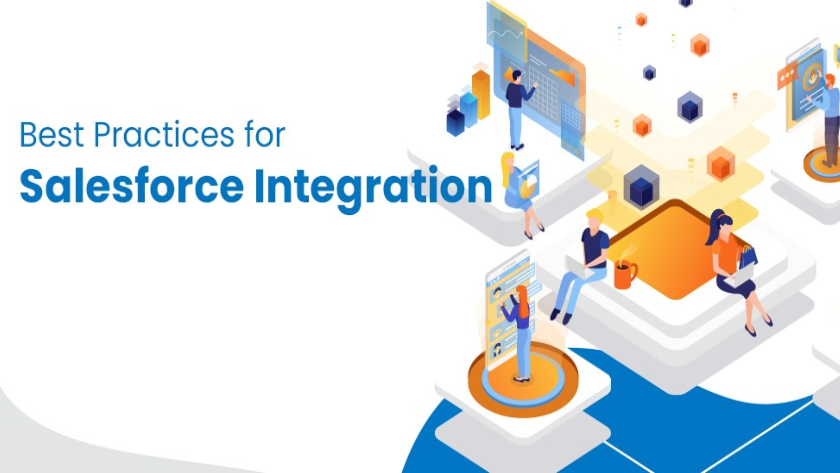Salesforce, a leading (CRM) platform, is renowned for its robust capabilities and extensive ecosystem. However, to fully leverage its potential, integrating Salesforce with other business systems is often necessary. Well-designed integration ensures seamless data flow, enhanced process efficiency, and comprehensive insights into business operations. In this blog, we will explore best practices for Salesforce integration including planning, execution, and post-implementation strategies to ensure a smooth and successful integration process.
1. Understanding Integration Requirements
Identify Business Objectives
The first step in any Salesforce integration is to clearly define the business objectives. Understanding what you aim to achieve with the integration helps in designing the right approach and selecting the appropriate tools. Common objectives include improving customer service, streamlining sales and others teams (i.e. finance) data collaboration, enhancing data accuracy, and providing better reporting and analytics.
Analyze Current Systems
Conduct a thorough analysis of the existing systems that will be integrated with Salesforce. Understand their data structures, communication protocols, and any potential integration challenges. This analysis helps in identifying compatibility issues and necessary customizations.
2. Choosing the Right Integration Approach
Point-to-Point Integration
Point-to-point integration is suitable for simple use cases where Salesforce needs to be connected to one or two systems. This approach is straightforward and involves direct communication between systems. However, it can become complex and difficult to manage as the number of integrated systems increases.
Middleware-Based Integration
Middleware-based integration, using platforms like MuleSoft, Boomi, or Informatica, provides a scalable and manageable solution for complex integration scenarios. Middleware acts as an intermediary that handles data transformation, routing, and orchestration, allowing for easier maintenance and future scalability.
API-Based Integration
Salesforce offers a comprehensive suite of APIs (REST, SOAP, Bulk, and Streaming) that facilitate robust integration with other systems. API-based integration is highly flexible and allows for real-time data exchange. It’s essential to choose the appropriate API based on the specific integration requirements.
3. Data Management Best Practices
Data Mapping and Transformation
Proper data mapping ensures that data from different systems is correctly aligned when integrated into Salesforce. This step involves defining how data fields from source systems correspond to fields in Salesforce. Data transformation may be required to convert data formats, units, or structures to ensure compatibility.
Data Quality and Cleansing
Ensuring high data quality is crucial for the success of any integration project. Perform data cleansing to remove duplicates, correct inaccuracies, and standardize data formats before integration. This helps in maintaining data integrity and reliability in the integrated systems.
Data Security and Compliance
Data security and compliance are paramount, especially when dealing with sensitive customer information. Implement robust security measures, such as encryption, access controls, and audit trails, to protect data during transit and storage. Ensure compliance with relevant regulations like GDPR, CCPA, or HIPAA.
4. Design and Architecture Best Practices
Use a Modular Approach
Design the integration architecture in a modular fashion, where each component or service can be independently developed, tested, and maintained. This approach enhances flexibility, scalability, and ease of troubleshooting.
Leverage Salesforce Integration Patterns
Salesforce provides various integration patterns, such as Remote Process Invocation, Batch Data Synchronization, and UI Integration. These patterns offer proven solutions to common integration challenges and help in designing efficient integration flows.
Implement Error Handling and Logging
Implement comprehensive error handling and logging mechanisms to monitor integration processes and quickly identify and resolve issues. Use tools and techniques that provide detailed error messages, automated retries, and alert notifications.
5. Testing and Validation
Unit Testing
Conduct unit testing on individual integration components to ensure they function correctly in isolation. This helps in identifying and resolving issues early in the development process.
System Integration Testing
Perform system integration testing to validate the interaction between integrated systems. This involves testing end-to-end workflows, data synchronization, and real-time data exchange to ensure seamless integration.
User Acceptance Testing (UAT)
Involve end-users in the testing process through User Acceptance Testing. This step ensures that the integrated systems meet business requirements and function as expected in real-world scenarios.
6. Deployment and Monitoring
Phased Deployment
Adopt a phased deployment approach to minimize risks and ensure a smooth transition. Start with a pilot phase, deploying the integration in a controlled environment, and gradually roll out to the entire organization after addressing any issues.
Continuous Monitoring
Implement continuous monitoring to track the performance and health of the integrated systems. Use monitoring tools and dashboards to visualize key metrics, identify bottlenecks, and proactively address potential issues.
Regular Maintenance and Updates
Regularly maintain and update the integration components to keep them aligned with evolving business requirements and technological advancements. This includes applying patches, upgrading software, and optimizing performance.
7. Common Challenges and Solutions
Data Consistency Issues
Maintaining data consistency across integrated systems can be challenging. Implement data validation rules, synchronization mechanisms, and regular data audits to ensure data consistency.
Handling Large Data Volumes
Integrating large volumes of data can impact performance. Use batch processing, data archiving, and incremental data loading techniques to manage large data volumes efficiently.
Managing Integration Complexity
Complex integration scenarios can be difficult to manage. Adopt a modular approach, use middleware platforms, and leverage integration patterns to handle complexity effectively.
Conclusion
Salesforce integration is a powerful strategy for enhancing business processes, improving data accuracy, and gaining comprehensive insights into operations. By following best practices in planning, execution, and post-implementation, businesses can ensure a successful integration that meets their objectives. Leveraging the right integration tools and staying abreast of emerging trends can further optimize the integration process and drive business growth. STREAMS Solutions, with its expertise in Salesforce integration, can help businesses navigate the complexities and achieve seamless, efficient, and effective integrations.





